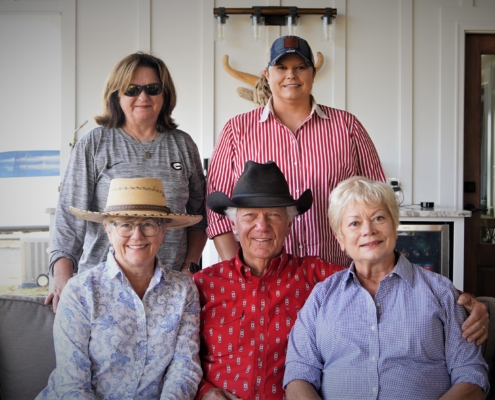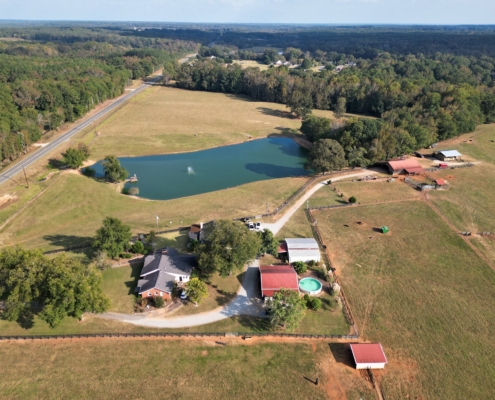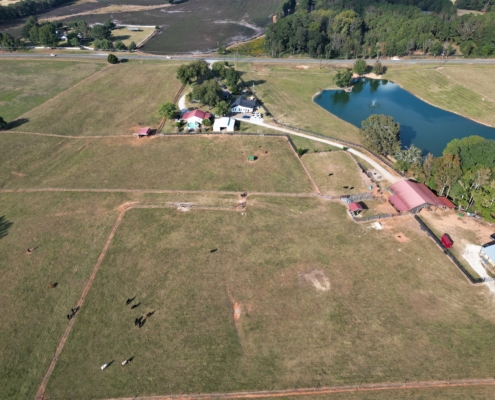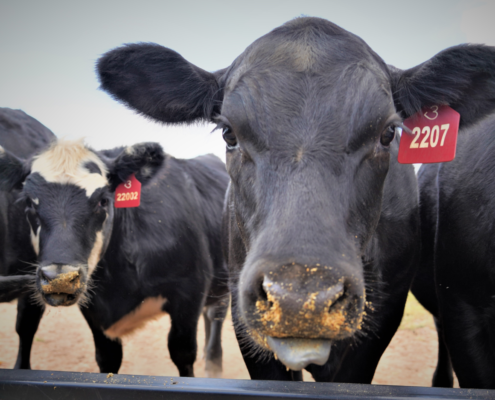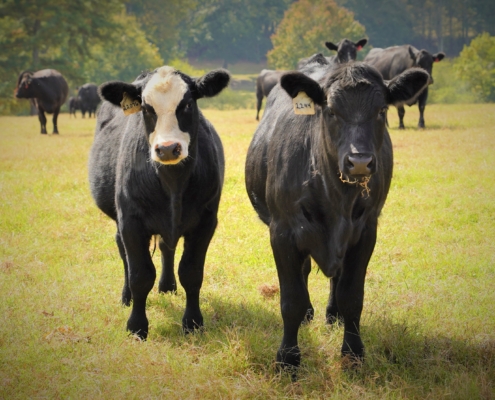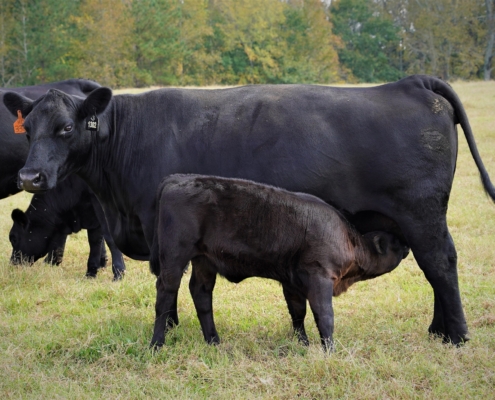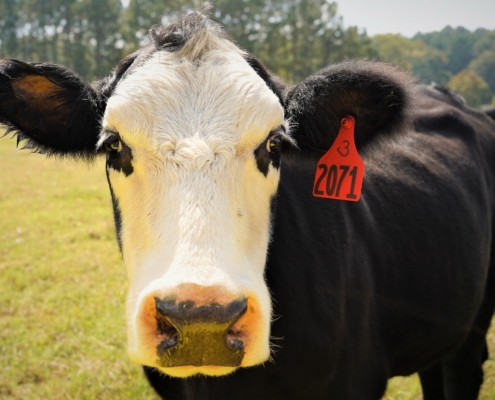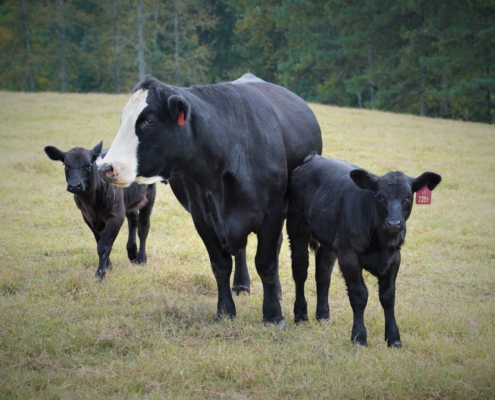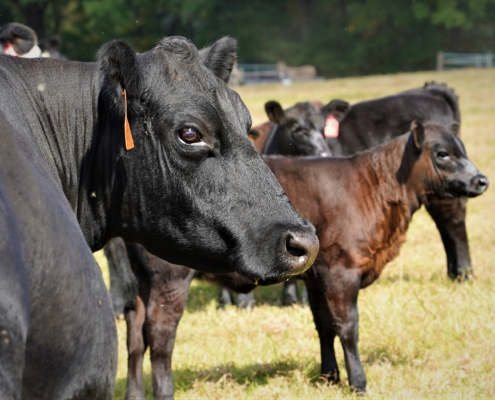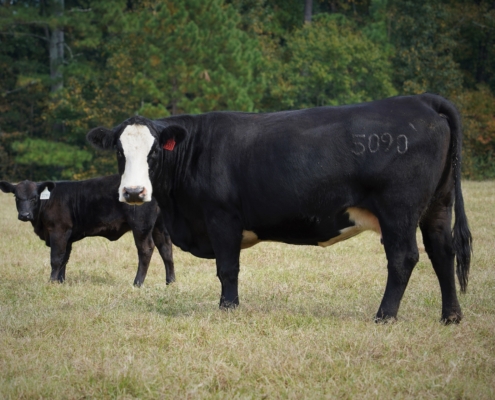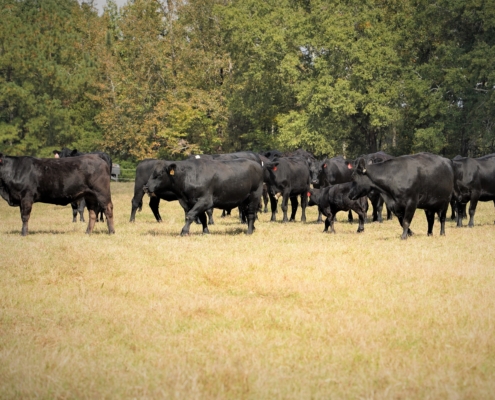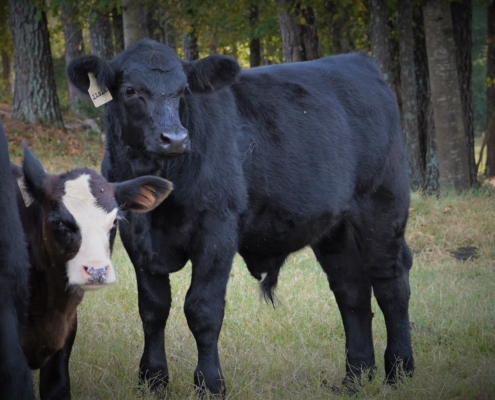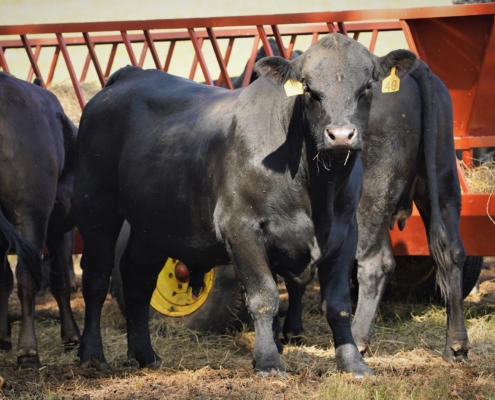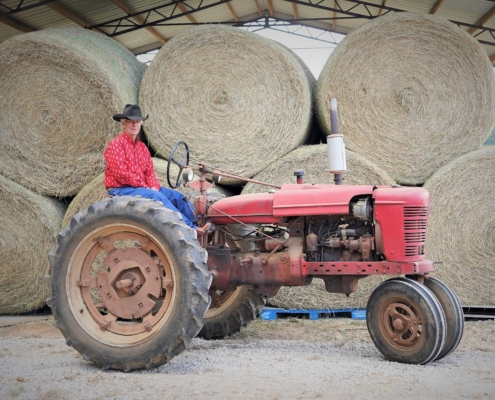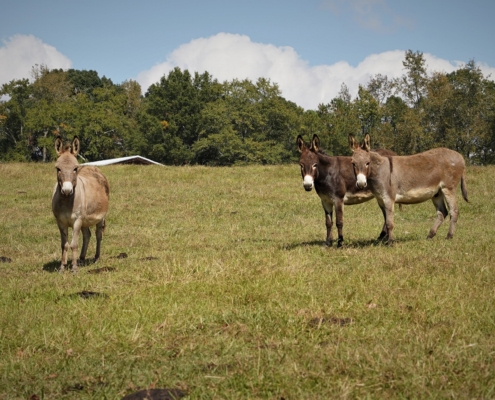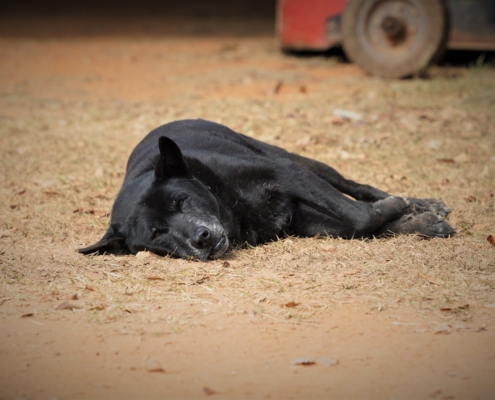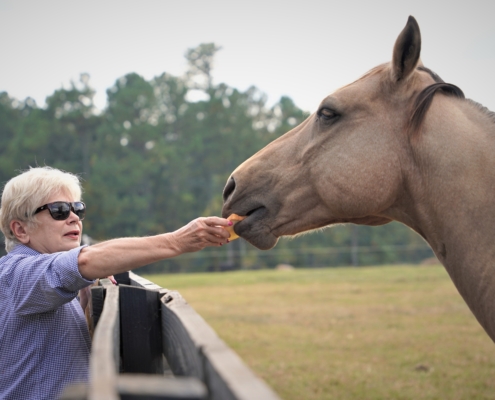3 Hearts Farm
Welcome to 3 Hearts Farm!
Meet Chuck and Linda Kimbell, Teresa Kimbell Akins, Tiffany Akins, and Lori Sayer.
Together as a family, they run a cow/calf operation, raising black angus on a beautiful piece of property located on Hwy 278 in Rutledge.
Check out the photographs of their farm and get to know Three Hearts in the Q & A session below!
The History Behind The Farm
The name Three Hearts represents the family names Herndon, Kimbell, and Akins, which make up the foundation and legacy of the farm. Three Hearts’ story begins in 1952, when Chuck and Teresa’s grandparents (last name Herndon), purchased the property in Morgan County and began farming cotton. Considered a typical family farm at that time, cotton was their primary source of income, however they also had milk cows, pigs, and chickens and sold eggs, butter, and milk to neighbors within the community.
Chuck and Teresa moved to the farm with their parents (last name Kimbell) in 1973 where they continued the farming operation while caring for their grandparents. The family name Akins arrived when Teresa married her husband. Both of her daughters continued the tradition and became farmers as well, Tiffany Akins is pictured above.
Four generations spanning 70 years have faithfully tended to this land, which transitioned to raising beef cattle in the 1970s. Specializing in genetics, as well as sustainable farming practices, Three Hearts prides themselves on producing quality and superior meat for the local market.
Get to know 3 Hearts Farm!
Check out the Q & A session below:
What type of farming do you do? – (Tiffany) “We are a cow/calf operation. We raise black angus, and they are just a lovely addition to what we call 3 Hearts Farm. Originally, we had horses and Chuck had a small herd of about 15 cows. In 2018 however, Chuck started teaching Lori and I and we fell in love with it. It’s a great stress reliever after work and ever since then we have worked on growing the herd. Wanting to get into the science behind it and see what we were producing, we started DNA sampling and began building our herd based on those results. Chuck has a saying, which sums it up perfectly “We hand pick the best for what stays here” and I think that’s very true.”
How long have you been farming? Are you a generational farmer? – (Chuck) “My grandparents moved to this land in 1952 and their last name was Herndon. Herndon, Kimbell, and Akins are the names of the three families that make up the foundation of this farm. In 1952 when my grandparents moved here, I was 9 years old. At the time, the farm included some chickens, hogs, and milk cows but cotton was their primary source of income. My grandmother would also sell milk and butter to local neighbors, and a few pigs, but cotton was the priority. In the 1950s all the harvesting was done by personal labor, and it was mothers, fathers, and many times children, who you would see picking the cotton by hand. As my grandmother and grandfather became older and their health started to decline, my mother and father moved us here in 1973 to take care of them. My dad worked for A&P in Atlanta, and he would drive there every day. My mother worked off and on at a dry cleaner in Atlanta as well. They would ride into the city together and often say that that was their special time with one another. My grandfather passed away in 1977 and my grandmother lived on for a good while with mom and dad. She actually outlived my father. That’s where Kimbell the second name came in, from my father. The third name, Akins, comes from my sister, her husband, and two daughters.”
What influenced you to continue the family farm operation? – (Chuck) “I think we all have a different opinion but for myself it’s home. I’ve lived in 5 different states in about 15 different houses, but I really feel like my roots are here. It never would cross our mind to be anywhere else.”
(Tiffany) “You see generational farms all around the area that end up being sold and developed for subdivisions. Our family actually spoke about this the other day, and I would have to be on death’s door to sell it. It gets harder and harder to farm. There is no way that we could continue to farm and treat the cows like we do, support ourselves and our families, without having full-time jobs to supplement the farm. It’s not for everybody. People always ask why we do this and it’s simply for the love of it. It’s not really a job for us. There’s been plenty of days where it’s cold, rainy, or hot or days where something goes wrong, like a fence is down, but it’s all worth it.”
(Chuck) “There’s always something to be done, always something more to do. If you don’t love it, if it doesn’t touch your heart, I would not recommend doing it.”
(Tiffany) “It’s not for everyone, it’s not. You definitely don’t do it for the money. You do it because it’s what you love.”
(Linda) “I love the way the family opens the farm up to different organizations. We have had church groups over here, groups from the hospital, a farm visit was recently a prize for a fundraiser to provide aid to the people of Ukraine. The family has also been very supportive of UGA’s health sciences campus, who had several international students who did not have the opportunity to go home for Thanksgiving and Chuck invited them up here to visit.”
(Tiffany) “We recently were able to host a farm visit that involved students from the high school college and career center’s nursing program and seniors from the local senior center. The nursing students were able to bring the seniors with the senior center’s van and they spent about half a day out here. They had the best time. Seniors and nursing students were able to feed the geese and the cows. One gentleman had never been fishing before, which was something he had always wanted to do, and during their time here we were able to take them all fishing. It was so great to see them enjoying themselves and making not only memories for themselves but for us as well.”
With raising cattle, how does the process go from start to finish? – (Tiffany) “We start with A.I (artificial insemination) in May. I guess to back up a little bit we get a little book that shows all of the bulls that are available. We look at the traits that we are wanting and then purchase the straws that we get from that and process those straws in mid-May. We do one round of A.I. and then turn in what we call a clean-up bull, so if they happen to slip that A.I. process then Big Mike’s responsibility is to catch that cow the very next heat cycle. In about 90 days a vet will come, and they will palpate the cows and tell if they are pregnant or not. The calves are born generally 9 months later, which is normally around February, beginning of March.”
(Tiffany) “Once that calf hits the ground, we kind of know within a week window of where they are. Normally heifers are born first, bull calves tend to take a little bit longer. When the calf is on the ground successfully, we will catch the calf and weigh them and make sure they are healthy and tag it. We will write down the dates and times, and make sure that it has gotten its first drink of milk from mom. Then we let them be a calf for a little bit. When we do the ear punch, we get the DNA sample which gets sent off to Neogen. They are known worldwide for animal DNA processing. About 7-10 days later we receive a 25-page report with all of the DNA samples from our calves with their traits ranked from 1 to 10, showing where they fall on that trait. This report is where we make our call on who we would like to keep. You’ve got anywhere from how much milk they will produce, to their maternal instinct, their docility, and their rib eye tenderness score. You can tell all different kinds of things from the Neogen testing. Awhile back, we took a UGA cattleman’s class where we were introduced to the idea. One of the speakers had taken the time to do the research behind it and after speaking with him we found an interest in it as well. It really helps us in the determination process. So far it has been remarkably accurate.”
(Tiffany) “After we make the determination based on the test results, we let the calves graze and grow with their mom until they are about 6-8 months old and then we wean them. Chuck built a great area for the calves that are ready to be weaned. The moms can come up to the fence and see them, where they will stay until they are ready to step away. Usually, it takes about two days and of course there is lots of mooing. We will feed them almost continuously throughout that time, giving them grain and hay, and talking to them. It’s not nearly as stressful as just taking the baby, putting it on a trailer, and sending it to a sale. So, at our farm, the mom chooses when to walk away from the calf and that’s how we wean. After the weaning process, we begin to calculate the calves’ weight at 3 different times throughout the year. Based on their weight and how quickly they are gaining, we try to put on 3 to 4 pounds a day on a calf. We have creep feeder that we fill that up and they can come up and eat anytime they want but we also still hand feed them so that way they are used to us. From that group we look at the heifers in the herd and determine which ones, if any, have aged out and are too old for reproduction and replace them with a newer model. Those then work their way into the herd and then become a part of the breeding process when they are between 15 and 18 months old. When we begin A.I with them, we always choose a low-birth-weight bull so we can almost guarantee how much that calf is going to weigh when it hits the ground. A more mature cow we can breed with a different bull type that will have a larger calf, but with a new cow we want a low birth weight for their first time. We use that DNA testing to look at their tenderness, their marbling score, and we pick that by their mom and their dad’s genetics and by looking at their registration papers. That’s how we decide who goes and who does not.”
(Chuck) “Because of the genetics and the selectively that we use on the animals, we have people who purchase directly from us. Some of them are meat processers and their customers have become used to having the quality meat that is produced here, so we don’t really have to take very many animals to the sale barn. They are normally just sold here right off the farm.”
After processing where does the meat go? Any local entities? – (Tiffany) “The private treaty that Chuck mentioned comes in here, it goes to another local farm, and I know some of the beef goes to a local restaurant and then they sell it out to different members of the community. The ones that we do sell that go to Northeast GA Livestock or Duvall Livestock, those go out to feed lots and are processed after that. We try however to keep it more local.
How does a typical day on the farm go for you? – (Tiffany) “During calving season you get up bright and early. If Chuck and Mom are available, they help. The cows get checked every morning, at least once by lunch, again when Lori and I get off work, and also throughout the night. When we are getting ready for calving season and going through the winter, it’s just making sure they have mineral, making sure their water tanks are good and fencing is good especially after a storm. Trees fall all the time. So far we have been lucky that none have hit a fence but that’s something you always need to be on the lookout for.”
What are some of the soil practices that are performed here? – (Tiffany) “We recently purchased a no-till drill and what that allows us to do is plant two different seed types at the same time. It makes a little slit in the ground, then a tube drops the seed into the soil, and then the back wheel covers it. It doesn’t even look like someone has planted anything and you don’t lose any seed from rain or erosion. By not tilling you actually save a lot of the nutrients that are already in the ground. When we take a soil sample, we see what the ground is lacking and if it needs nitrogen we plant some rye, which puts nitrogen back into the ground. When we sample again in the spring and it’s still low in nitrogen, we add that into the fertilizer we put out, to make sure that the ground is where it needs to be. If we don’t take care of the soil, it won’t provide us any grasses for our cows.”
(Chuck) “If you don’t have the nutrients in the soil, it then shows within the texture and the quality of the grass.”
(Lori) “Right now we are waiting for rain, and we need a few days of it to soften the ground so we can plant winter rye. That usually lasts until April until it starts getting hot.”
What is your favorite thing about being a farmer and working on this land? – (Chuck) “It just touches my soul.”
(Tiffany) “I think it’s different for everyone here. Chuck and Mom (Teresa) have been here of course the longest and we’ve watched what they have done over the years and have learned everything from them. We want to continue all the hard work that they have put in. Back when I was in high school, Chuck and my dad spent weeks plowing up the back field. They had pine trees taken out and had plows out there for at least two weeks getting the dirt ready for the Bermuda they ended up planting. I remember Chuck leaving one day, still waiting for the Bermuda seed to come in, and there was no rain in sight. About 30-45 minutes after Chuck left, one of the biggest monsoons started. I think we may have gotten over an inch of rain and because of that, Chuck had to do that field over again. A lot of people would have thrown their hands up in the air, but he didn’t. I think that describes a lot of what a farmer is. You walk through some of the hardest times, you lose money more than you make money, and you sometimes have to do a job multiple times, but you never complain, you just do it. We planted a lot of seed this last summer, when rain was in the forecast, and it never came. We waited and waited for rain to come and only about 40-50% of the grass came up because the geese went and dug it all up with their beaks and ate it. But that’s just being a farmer. You expect the failure.”
(Lori) “You have to have the love; you have to have the passion. I grew up on a farm in South Georgia and then I came here, and I have that same love for this land as Chuck and Teresa do. It’s just something that’s bred in us.”
(Teresa) “People ask us where we live, and when we tell them they always say what pretty place it is and compliment us on how well we keep it up. Everybody seems to recognize the farm and it makes you so proud when they do. It makes you want to do more and do better each time.”
(Tiffany) “I think a lot of people don’t know or realize where their food or clothing comes from. There’s a slogan out for one of the campaign ads, “It takes a farmer” and it caught my attention because it’s so true. Farmers have the will and the drive to be out in the elements and do what it takes to get that commodity or animal to where it needs to be. I’m proud to say that I can be this minute grain of sand in that big overall picture.”
What can the community do to support farmers like you? – (Tiffany) “Buying local and supporting your farmer on the roadways. Especially around here, I know we’ve all been stuck behind a tractor on the road. Take a breath and don’t be upset at us for being on the road driving to a different field. Take that moment to realize this farmer is doing this for the community and their neighbors.”



